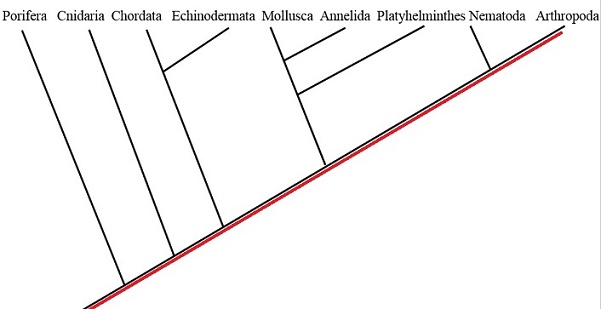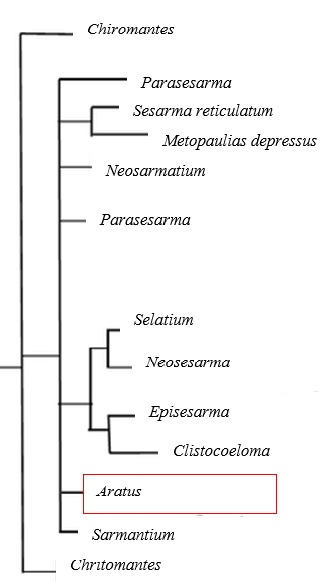Classification
Domain
The Aratus pisonii is in the Eukaryote domain. A
characteristic that places the tree crab into the Eukaryote domain
would be its membrane bound organelles. This includes
organelles within the boundary of the cell membrane including the
nucleus and mitochondria. Eukarya covers a very wide range of
organisms including plants, animals and fungi as well as a variety
of protozoa including
Pyrocystis fusiformis.
Major
Clade
The major clade Opisthkonta plays host to the Aratus pisonii. The
major characteristic represented by the tree crab that places it
into this clade is its rear-mounted flagellum. Fungi, such as
Morchella esculentoides, are another member of this clade.
Kingdom
The tree crab falls into the Kingdom Animalia. Characteristics
that make this true include the lack of a cell wall and the absence
of chloroplasts. The tree crab is also heterotrophic, as it
does not fix its own carbon.
Phylum
Arthropoda is the phylum to which the tree crab belongs too.
Major characteristics for this include the presence of an
exoskeleton, jointed legs and appendages, bilateral symmetry, and a
body divided into distinct parts. Another member of this
phylum is
Xylocopa virginica, or the eastern carpenter bee. The tree crab also falls
into the subphyla of the Crustaceans. Synapomorphies of this
group include two body regions, five or more pairs of legs, two
pairs of antennae, and the ability to reside in both aquatic and
terrestrial habitats (Arizona, 1997).
This phylogenetic tree is representing the phyla within the Kingdom Animalia. The mangrove tree crab is in Kingdom Animalia and falls into the Arthropod phylum.
Class
The mangrove tree crab falls into the Malacostraca class. In
being in this class, the crab exhibits three main sections including
the abdomen, thorax, and the head. It also has about 19-20
jointed body systems. Another characteristic of this class is
the presence of an open circulatory system (New Hampshire Public
Television, 2014).
Order
The order of
the tree crab is Decapoda. Classification here includes the
presence of ten legs, as well as a well-developed carapace (Decapod
Crustaceans, 1999).
Family
The tree crab belongs to the family Sesarmidae. The
distinguishing characteristic for this would be the ability of the
crab to climb trees in the terrestrial environment (Cumberlidge et
al, 2009).
Genus
Aratus pisonii is currently the only species in the genus Aratus.
It characteristic here is the lack of lateral spines on its carapace
(Smithsonian, 2009).
Illustrated is a phylogenetic relationship displaying the genera of the family Sesarmidae. (Shubert et al, 2006)
Species
Once again,
the tree crab is the only species within its genus, so its
distinguishing characteristic separating it from other members of
its family is the lack of lateral spines on its carapace
(Smithsonian, 2009).
Go back to the Home page or learn more about this species in the Form and Function page.


